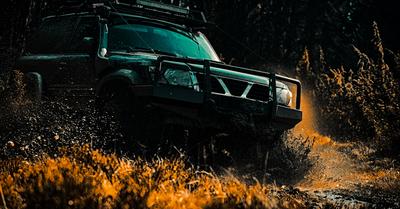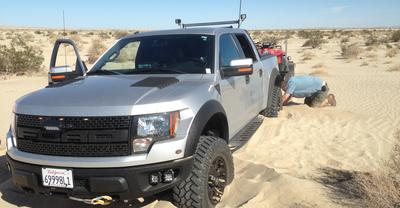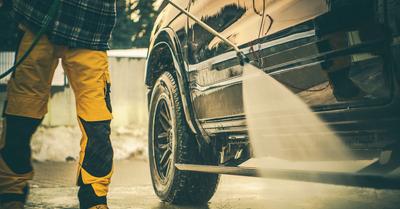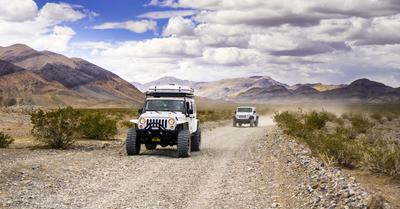Off-road adventures can take your vehicle to its limits, but having a reliable and well-built suspension plays a crucial role in ensuring a smooth ride.
To build an off-road suspension,
- Select the Right Suspension Type
- Remove The Old Suspension
- Design The New Suspension
- Install The New Suspension
- Measure, Fit, and Install The Oversized Tires
- Test Drive & Make Adjustments
This guide will present a quick and easy guide to building your off-road suspension system. We'll walk you through the process, highlighting crucial steps, offering expert tips, and making sure you're equipped with the knowledge to transform your ride into a true off-road warrior.
Key Takeaways
- Select the Right Suspension Type, Remove The Old Suspension, Design The New Suspension, Install The New Suspension, Measure, Fit, and Install The Oversized Tires, and Test Drive & Make Adjustments to build an off-road suspension.
- An off-road suspension should last about 50,000 miles before you notice reduced performance.
- A solid axle suspension is the best suspension type for off-road driving.
This article may contain affiliate links where we earn a commission from qualifying purchases.
How To Build Off-Road Suspension: A Quick and Easy Guide
If you are an off-roading enthusiast, you know that the quality of your ride largely depends on the effectiveness of your suspension system. Off-road suspension is pivotal for maneuvering tough terrains while ensuring comfort and durability.
It's the key to a smooth ride, enabling your vehicle to handle harsh terrains with ease and prowess. Here are the steps we recommend you follow to build a reliable off-road suspension system successfully.
Step One: Selecting the Right Suspension Type
When building off-road suspensions, the first step is to choose the right suspension type for our specific application. Several suspension systems are available, such as a solid axle or independent suspension.
As we research, we should consider factors like our off-roading style, driving conditions, and vehicle. Usually, the solid axle suspension travel type is the most recommended for extreme off-road riding.
Step Two: Removing Old Suspension
The next step towards upgrading your off-road suspension is removing the old one. Safely raise your vehicle using a hydraulic jack, and jack stands, then remove the wheels.
Start by detaching the shock absorbers, followed by the springs. Take note of how everything is connected; a reference photo can be a great help.
Safety is paramount, so always wear appropriate protective gear and ensure the vehicle is secure before beginning any work.
Step Three: Design The New Suspension
Designing the new suspension is a critical step that will significantly influence your off-roading experience. We can create a unique off-road suspension design from scratch or use a pre-built kit.
Based on the vehicle's specifications, terrain preference, and driving style, choose the right type of suspension - be it leaf springs, coil springs, independent front suspension (IFS), or solid axle suspension.
Always ensure the new design has the correct load capacity for your vehicle's weight and the rigors it will face on off-road trails.
Step Four: Installing New Suspension
Once you have all your new suspension components and have designed your system, it's time for the installation. Follow the manufacturer's guidelines carefully to avoid mistakes.
Begin with the springs, ensuring they are correctly positioned and securely fastened. Follow this with the shock absorbers.
Ensure all components are tightly secured but not overly tightened to allow for movement. Keep track of all hardware and fastenings, as missing pieces can lead to a malfunction.
Step Five: Fitting Oversized Tires
Now that you have your new suspension installed, it's time to fit those oversized tires for better ground clearance and improved off-road traction. Remember, bigger tires demand more from your suspension, so ensure your newly installed system can handle the additional strain.
Also, check your vehicle's wheel wells and fenders to ensure ample space for the larger tires. If the tires rub against the vehicle, you may need additional modifications, like trimming the fenders or adding wheel spacers.
Step Six: Test Drive
After everything is installed and you've double-checked all your work, it's time to hit the road for a test drive. Start with a slow drive on a paved road to check the general handling, steering, and braking.
Always consult your vehicle's specifications and follow all safety guidelines during the process. Listen for any unusual noises and pay attention to how the vehicle responds to bumps and turns.
Once you're confident everything is functioning correctly on a regular road, slowly introduce the vehicle to off-road conditions. Start with light off-roading and gradually move to more challenging terrains.
What Makes a Good Off-Road Suspension?
As off-roading enthusiasts will tell you, a vehicle is only as good as its suspension system. But what exactly makes a good off-road suspension? Let's delve into the key factors contributing to an effective, reliable, and sturdy off-road suspension.
1. Durability and Strength
A good off-road suspension system should be built to withstand the rigors of rough terrains. This involves solid construction using high-quality materials to ensure longevity and prevent breakdowns during your off-road adventures.
2. Flexibility and Articulation
Off-road trails are often uneven and rocky. A good suspension system should offer excellent articulation, allowing the wheels to move independently and keep in contact with the ground as much as possible, even on uneven surfaces.
3. Ground Clearance
The best off-road suspension systems will offer increased ground clearance. More height allows the vehicle to overcome bigger obstacles without damaging the undercarriage.
It also improves the vehicle's approach, departure, and break-over angles, making handling steep inclines and declines easier.
4. Load Capacity
Whether for carrying additional equipment or towing, a good off-road suspension system should have an adequate load capacity. It should maintain performance and control even under the added weight.
5. Comfort
While off-roading isn't a smooth ride, a good suspension system can make a significant difference in comfort levels by absorbing most of the shocks caused by bumps and dips.
Understanding Off-Road Suspension Fundamentals
A properly built off-road suspension system is essential to every off-road adventure. This complex system is designed to manage the irregularities of challenging terrains and deliver a smoother and safer ride.
Here, we’ll delve into the fundamentals of off-road suspension systems.
Importance Of Ground Clearance
Ground clearance is crucial when off-roading to avoid getting stuck or damaging your vehicle's undercarriage. Without it, off-road vehicles would experience major issues on trails.
Having a higher ground clearance allows us to traverse more uneven terrain, and it's one of the main reasons off-road enthusiasts invest in suspension kits and lifts.
We can increase the ground clearance by adjusting the suspension system and installing larger tires. Adequate ground clearance improves off-road performance and allows us to explore more challenging terrains confidently.
Function of Off-Road Suspension
The off-road suspension system is designed to allow you to drive over rough terrains while ensuring comfort and control. It serves several purposes:
- Absorbing Shock: The suspension system absorbs the shock from bumps and dips, reducing the impact felt inside the vehicle and preventing damage to the vehicle itself.
- Ensuring Tire Contact: It helps maintain constant tire contact with the ground, ensuring better traction and control.
- Providing Ground Clearance: An off-road suspension system lifts the vehicle higher off the ground, improving its ability to cross obstacles.
Basic Off-Road Suspension Components
Shocks and springs play a crucial role in off-road suspension systems as they absorb and dissipate energy from uneven terrain. This includes coil springs and leaf springs.
They protect our vehicle's components and maintain balance and control during off-roading adventures. For instance, off-road suspensions like coil-over suspension lift kits have become more popular and affordable in modern trucks and SUVs.
Springs support the vehicle's weight and provide the necessary force to maintain ground clearance, articulation, and load distribution. Shocks provide damping for the suspension, preventing excessive oscillation and bouncing. Other components include:
- Shock Absorbers: These dampen the motion of the springs, controlling the bouncing movement you'd experience after hitting a bump.
- Linkages: These are the bars and brackets that connect the various parts of the suspension to the chassis and allow for movement.
- Tires and Wheels: These are crucial in absorbing some of the shocks from the road and providing traction.
- Bushings: These are placed in between the moving parts of the suspension system to reduce vibration and noise.
Types Of Off-Road Suspensions
As an off-roading enthusiast, it's essential to know what lies beneath your vehicle - the suspension system. It's the heart of your off-roader, letting you traverse rocky, uneven, or challenging terrains with relative ease. Let’s review the two primary off-road suspension types.
Solid Axle Suspension
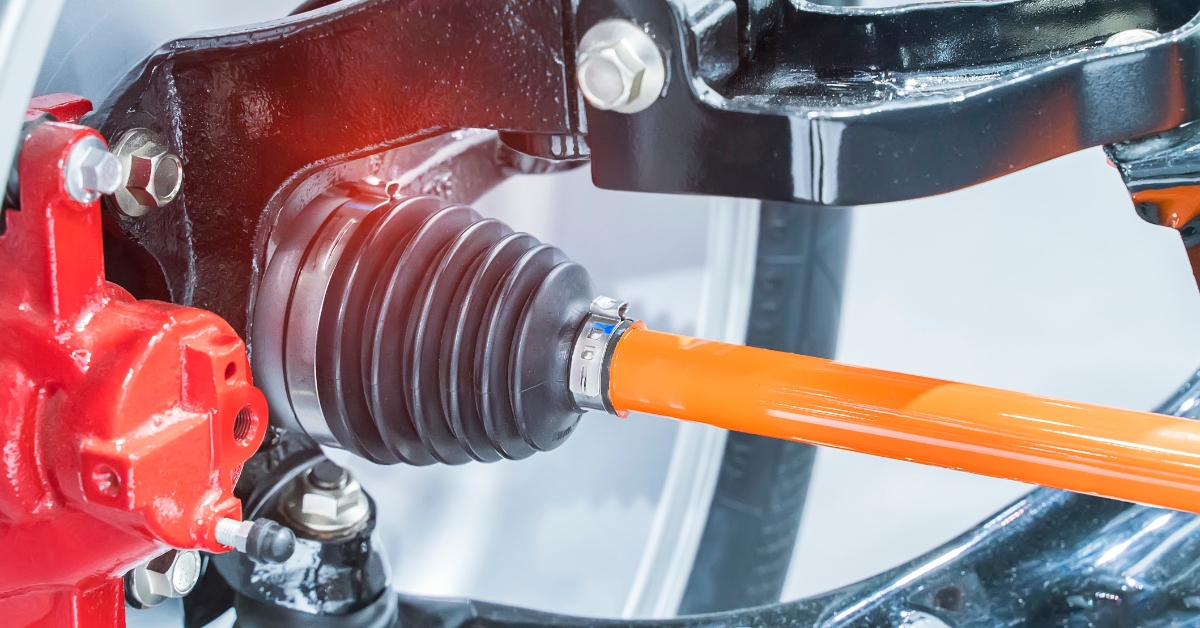
Solid Axle Suspension
Often referred to as a 'live axle' or 'beam axle' suspension, Solid Axle Suspension is one of the oldest and most reliable types of off-road suspensions, including SUVs, trucks, and Jeeps.
With a solid axle design, the wheels on an axle are connected by a solid beam. The beam allows both wheels to move in sync, meaning if one wheel moves up or down, the other does the same. So the rear solid axles and axle housing are sturdy.
Pros
- High-strength solid beam axles can withstand the harsh conditions of off-roading without easily getting damaged.
- Offers excellent articulation and allows the wheels to move independently, which is beneficial when traversing uneven terrains.
- Solid axle systems are relatively easier to modify or lift.
Cons
- Can’t match the same level of ride comfort and smoothness
- Not as reliable at highway speeds
Independent Front Suspension
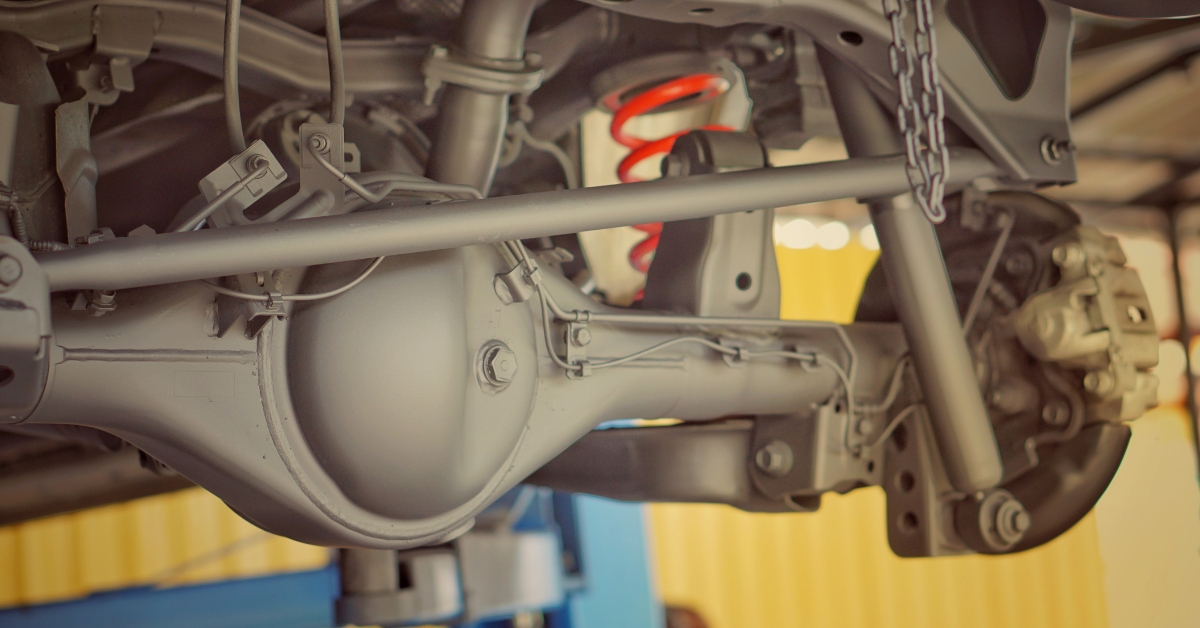
Independent Front Suspension
As the name suggests, the Independent Front Suspension allows the front wheels to move independently of each other. This type of suspension is commonly found in many modern 4x4s.
In an independent suspension setup, each wheel on an axle is allowed to move independently. So, if one wheel hits a bump, the other isn't directly affected. This allows you to raise the a-arm suspension (Double Wishbone Suspension) and handle rough terrain.
Pros
- It provides a smoother ride over bumpy terrain
- Improved handling in more extreme off-road conditions
- Independent suspension system is durable and ranks as the best off-road suspension type
- Ground clearance changes with the suspension cycles
Cons
- Much more complex system
- Not as robust as the solid axle
Upgrading Your Existing Suspension
Aftermarket Suspension Lift Kits
When it comes to off-road performance, an aftermarket suspension lift kit is essential. These kits provide increased ground clearance, allowing for larger tires and enhanced off-road capabilities.
Lift kits often include sturdier springs, dampeners, and other components for rugged terrain. We recommend researching the best lift kits available for your specific vehicle model to ensure compatibility and optimal performance.
Adjustable Shocks and Coilovers
Upgrading to adjustable shocks and coil overs is another vital step in off-road suspension. Adjustable shocks allow us to fine-tune the damping characteristics to match the terrain and driving style, while coil overs can significantly enhance ride quality and stability.
When making these upgrades, consider your vehicle's weight and how you plan to drive it. Expect better handling and overall driving comfort when properly upgrading the shocks and coils.
Upgrading Bushings, Links, and Joints
Finally, let's not overlook the importance of upgrading bushings, links, and joints. Stock bushings can wear out quickly when subjected to the rigors of off-roading, leading to imprecise handling and increased wear on other suspension components.
Upgraded polyurethane bushings offer increased durability and better handling. Similarly, reinforced links and joints strengthen the suspension, ensuring that every component works together efficiently.
How Long Does An Off-Road Suspension Last?
Off-roading offers a thrilling adventure, but it also places heavy demands on your vehicle, particularly your suspension system. The length of time it can be expected to last varies.
The longevity of your off-road suspension system primarily depends on the type of terrain you usually traverse and how frequently you use your vehicle for off-roading. Other factors include the quality of the suspension system, its maintenance, and the type of vehicle it's installed on.
In an ideal situation, an off-road suspension should serve you well for many years. However, under heavy-duty use in harsh terrains, components of your off-road suspension system may begin to show wear and tear somewhere around the 50,000 miles mark.
This is not a hard and fast rule but a guideline based on typical usage patterns. At this juncture, it's highly recommended to have your suspension system thoroughly inspected for any signs of damage or wear.


